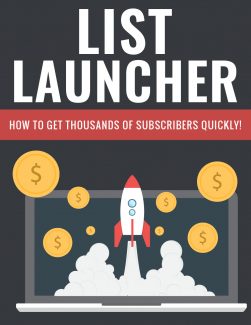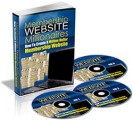 License Type: Private Label Rights
License Type: Private Label Rights  File Type: ZIP
File Type: ZIP
 SKU: 61959
SKU: 61959  Shipping: Online Download
Shipping: Online Download
Sample Content Preview
Introduction
A mailing list will always be one of your most valuable business assets. With it, you can connect with your target audience, build brand awareness, tap into hot niche markets, and maximize your income through affiliate marketing and product launches.
What you want to do is build a mailing list that is organized and segmented so that you are able to communicate your message clearly and to the right audience.
I’ll show you exactly how to do that in this report, as well as how to increase opt-in rates as well as open-rates so that your emails are seen by thousands of subscribers who will respond to your messages, and buy your products.
Are you ready to start building a profitable, laser-targeted mailing list of your own?
Then, let’s begin.
Building A Solid Foundation
One of the biggest mistakes that new email marketers often make is in pushing every subscriber into the same mailing list funnel.
Rather than segment their audience so that each subscriber is sent into a specific mailing list based around their interests, they build massive mailing lists filled with subscribers from every walk of life.
Not only does this make it incredibly difficult to later target subscribers with offers that are tailored around them, but it becomes virtually impossible to personally connect with prospects!
Don’t make this mistake. Create the foundation for a profitable mailing list campaign by segmenting your list from the beginning.
Here’s how to do that:
Create multiple email lists within your mailing list account. If you don’t yet have a mailing list provider, you can visit http://www.Aweber.com or http://www.GetResponse.com (two of the most commonly used providers online). Every list you create within your account should have a strong focus around a specific topic.
Add your opt-in code to specific pages on your website rather than the same subscription box on every page.
For example, if you own a blog that offers tips and information on writing, you might want to create a mailing list around all the sub-sections of your niche, such as: Self-Publishing, Ghostwriting and Freelance Writing.
Your opt-in box would direct subscribers to a different mailing list based on the page they are reading. That way, subscribers choose for themselves what mailing list best suits them by being able to subscribe to specific offers.
Every opt-in page should feature a different incentive offer that speaks directly to your audience, and connects with what is most important to them.
Using our earlier example, on a blog for writers, an incentive offer on the “Self-Publishing” blog page might include a free eBook template, while on the “Freelance Writers” page, it could feature a checklist for Freelancers. Subscribers receive the freebie after entering their name and email address and joining your list.
Setting up your website this way makes it easy to segment your audience because you’re putting them in control. Rather than adding every subscriber into one mailing list that ends up difficult to target, you’ll know exactly what your subscriber is most interested in.
If you aren’t sure how to add opt-in boxes to your blog or website, check out https://conversiongorilla.com/ where you can create customized opt-in boxes easily.
You’ll be able to change the color, overall appearance as well as when the opt-in form appears. You can even go so far as to have the opt-in code triggered only when someone attempts to exit your page.
Laying The Groundwork
The next step is to create your autoresponder sequence. This is another area that new email marketers often overlook as not being an integral part of their sales funnel.
So, they create their mailing list, generate the opt-in code and place it onto their website in order to capture leads, but they haven’t done anything on the back-end to keep those subscribers.
Don’t make this common mistake. It’s important to open the channel of communication and start a dialogue with your subscribers from the very beginning. Your list will run cold very quickly if you fail to connect with your prospects from the early stages of introducing your brand.
Your autoresponder messages work for you 365 days a year, so if they’re set up correctly, they have the power to keep sales pouring in, even when you’re not even at your desk. They’re one of your most valuable assets so don’t overlook the importance of continuously working on extending your autoresponder sequence.
Here’s how to do it:
Create a series of autoresponder messages that are sent in a carefully planned sequence.
The first email should go out to your mailing list immediately after they subscribe. This message would contain the download link to the incentive offer featured on the opt-in page that motivated them to sign up in the first place. It should also introduce your brand, and highlight the benefits of staying on your list.
This is called “warming up your list” because initially your email list is cold. Those people probably don’t know much about you, or what you have to offer.
Sure, they subscribed to your list because you offered them a cool incentive that they felt was worthy of their name and email address. But that’s it. That’s all they know about you.
So, you’re first email warms them up, introduces your brand and reminds them who you are, and how smart they were to have joined your list because of all the great things you have in store. That’ll build excitement and anticipation, and help to keep them on your list.
The second email could go out the next day, or 2-3 days later. This email should begin to build brand awareness. You don’t want to inundate your subscribers with paid offers just yet.
This is the time to build a relationship and trust with your audience. The objective is to become an authority in your market, and for your subscribers to turn to you for advice and guidance on products and services that will help them.
This doesn’t mean that they want to receive advertisements from you just yet, though. You haven’t earned that yet. While other people will argue that rapid-fire advertising campaigns can be effective, it’s always best to provide exceptional value upfront before asking for a commitment to purchase anything through your links.
So, consider offering your subscribers an additional incentive for free. The first one got them into your mailing list. The second one will keep them there.
Your third email can be sent within the first 7 days, and here’s where you can begin to start monetizing your list.
Start by conditioning your audience to open your emails by combining an equal balance of useful and informative content (that doesn’t sell anything), with paid offers and promotional campaigns.
One thing you will want to do it direct your subscribers to your website or blog whenever you can. Instead of filling up your email with all the information they need, break it down so that your email only features the most important nuggets that’ll capture their attention and motivate them to click your link to find out more.
You can also use your social media accounts to further connect with your audience on a more personal level.
Send them links to photos or memes on Instagram and Pinterest that they may find amusing.
Don’t be afraid to be personal and be real with them. The more laid-back and genuine you are, the better your subscribers will respond to you – and the more likely they’ll remember your brand.
Make sure to test out your entire sequence by forwarding it to your own email address. Read through your autoresponder messages. Proofread. Check the links. And then continue to build on your back-end autoresponder system by incorporating additional emails into the sequence.
You should spend a few hours a week creating new content for your mailing list. Then, once a month go through your autoresponder campaign to update any older emails or swap out product links for newer offers.








